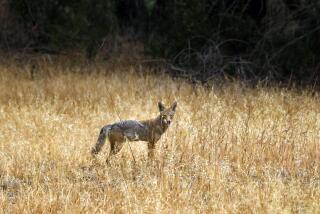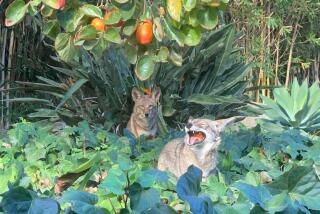A neighborhood on coyote watch
The midday knock on my front door came from a neighbor I didnât know, though we had lived for years on the same short block in Northridge.
She was going door-to-door with a warning that sheâd spotted a coyote â in the middle of the day, on our cul de sac, in the yard next door to my house.
I propped a pillow against the doggy door and launched a frantic hunt for my two little dogs. I found them napping under my desk, unaware of how close they had come to becoming spoils of war.
Iâve lived 25 years in this neighborhood â bordered by a freeway and a shopping mall, itâs about as urban as they come. Weâve learned here to appreciate our local wildlife. The rules are clear enough.
Weâll veer around the snakes we encounter on our foothill bike rides. Weâll stop for slow-moving raccoon families on busy Tampa Avenue. Weâll try not to startle the deer we spot on Limekiln Canyon walks. Weâll pause to let the lizards skitter off when we open our front doors in the morning.
But this takes the concept of co-existence to a whole new level. The coyotes have the upper hand; the pets and people are on lockdown.
I must have sounded a little overwrought when I called wildlife expert Larry Hawkins for advice. Hawkins is a public affairs specialist for the U.S. Department of Agricultureâs Animal and Plant Health Inspection Service.
I love animals, I told him. But not wild ones trolling my neighborhood, with killer instincts and sharp teeth. I want to let my dogs play in their backyard. I donât like giving up my freedom.
âI donât know whether to tell you to talk to a wildlife biologist or a pastor,â Hawkins said. âCoyotes are such an emotional issue, itâs hard to talk about just the science.â
I understand what he means by that. From a distance, coyotes are thrilling to listen to and fascinating to watch. But up close, they bring our vulnerability into terrifying focus.
Itâs easy to be enchanted by the antics of Glen Bearian, the bear who raids garage refrigerators and takes dips in backyard pools. Itâs natural to mourn the wandering mountain lion shot to death in an office courtyard in Santa Monica.
But itâs a different story with a coyote, whoâs apt to leap a fence and snatch your Pomeranian from your suburban backyard.
Hawkins has spent 20 years trying to smooth the relationship between humans and coyotes. In the last few years, things have been tipping toward the animalsâ side.
âItâs a progression,â he said. âFirst we hear them, maybe at night. Then you see them at dusk or at dawn. Then you begin to see them more commonly during daylight hours. Then you see them in somebodyâs front yard, then on someoneâs porch.â
Heâs describing whatâs happened on our block this summer: Miles spotted a coyote on an early morning bike ride. Rich found one asleep in his fire pit. Diane shooed one out of her back yard. Eddie stared one down from his driveway. Then, two weeks ago, Matt needed a baseball bat to chase one out of his yard.
And itâs not just foothill neighborhoods. Coyotes have been spotted strolling through tourist spots in Hollywood and foraging through Trader Joeâs trash bins on Ventura Boulevard.
âTheyâve become part of the urban landscape,â Hawkins said. And it wonât be easy to get them to move on. The more time they spend in our neighborhoods, the less afraid of us they are.
âCoyotes are drawn to areas occupied by people because they like the way we live,â he said. âLife is easier when other predatory animals are not preying on you, when you can eat an orange from somebodyâs backyard tree, eat out of the dog bowl, or eat the cat or the dog.â
You donât have to spot a coyote to know your neighborhood has a problem, he said. Just survey your fences and lamp posts. âMissing dog. Lost pet. If youâve seen Fluffy, please call.
âWhen you see a bunch of those signs and theyâre concentrated in a certain geographic area ⌠I can tell you where theyâre going. They have been a meal.â
Hawkins said the public perspective on the coyote issue has begun to evolve.
âIt was âDonât ever touch them. They were here first, we should leave,ââ he said. âNow thereâs a more balanced approach.â
And a recognition that the old advice â fence off your yard, clear trash and brush, donât feed or water animals outside â simply isnât enough.
Now our co-existence depends on our willingness to be moderately cruel: Pelt them with rocks or blast them with a hose when you spot them in your yard. Carry an air horn when you walk, the noise will run them off.
âAnything you can use to make them uncomfortable and haze them away from people ⌠helps reshape their behavior,â Hawkins said. âBut only if itâs consistently enforced.â
And be prepared for battle, because theyâre bold and smart and not afraid of you or your dog.
âThe last thing I want to do is paint a grim picture of coyotes,â said Hawkins, who lives in the foothills near Sacramento. âBut I wouldnât have a doggy door. I donât leave my dog out during the day. And I have a fence that is more than 6 feet tall.â
Now Iâm walking my dogs in daylight hours, eyes peeled and pockets loaded with rocks. I startle at the sound of a leaf blowing behind me and worry that every hedge hides a coyote about to pounce.
But if thereâs a bright side to our neighborhood saga, itâs a friendly sense of mission. Strangers greet each other on the streets, waving our golf clubs and baseball bats when we pass, holding our pets tightly leashed.
And Iâm trying to come to grips with my fears, but itâs more than freedom I miss:
Iâve gone from seeing coyotes as lovely wild animals we have the privilege of living near to frightening, heartless predators that Iâm willing to pelt with rocks.
More to Read
Sign up for Essential California
The most important California stories and recommendations in your inbox every morning.
You may occasionally receive promotional content from the Los Angeles Times.










